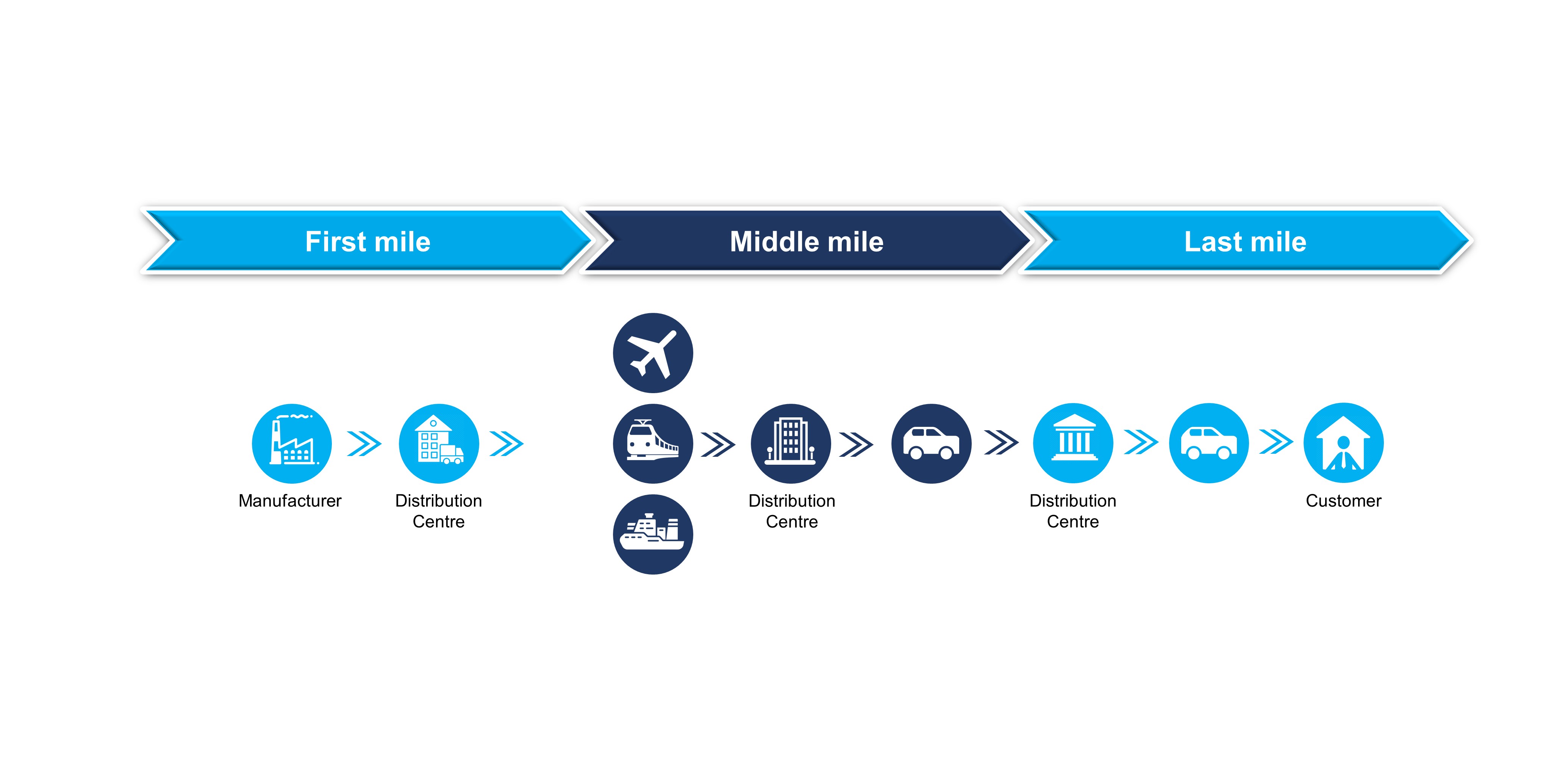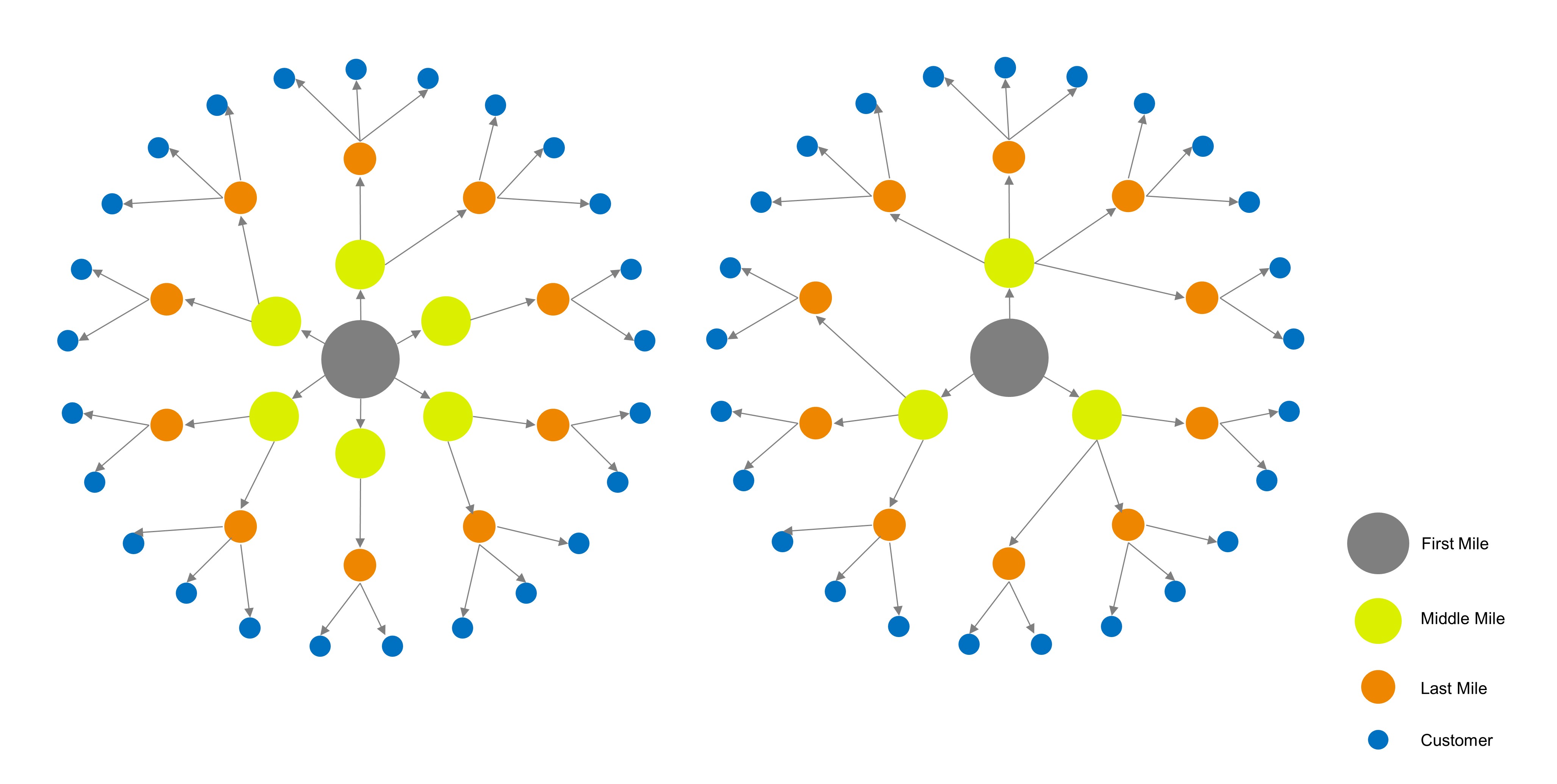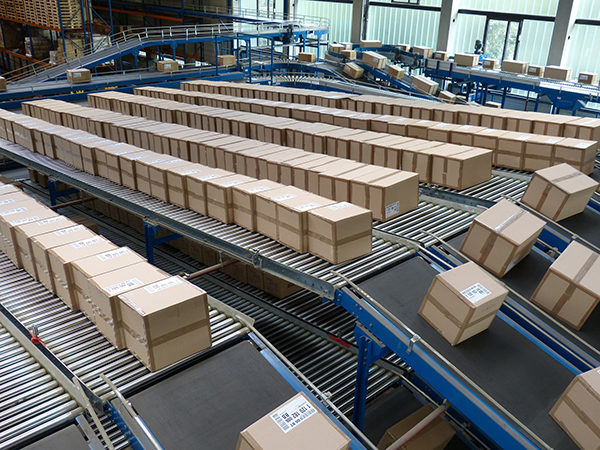The past decade has seen a shift from a one step to a multiple step supply chain model for online retailers. As reported by Deutsche Bank last year, heightened delivery demands of e-commerce users are forcing participants to shed models built around a “straight-forward” first, middle and last-mile supply chain in favor of “fragmented” networks supporting the positioning of inventory near the final destination. This shift, therefore, makes the question even more relevant.

|
First Mile |
Middle Mile |
Last Mile |
|
The first mile is the transportation of the product from the manufacturer to the middle mile, where it is then further distributed downstream. |
In the middle mile, the products received from multiple upstream partners are sorted for transportation to the last mile. |
The last mile is the last leg in the product’s journey to its final destination, which is the customer.
|
Sortation centers are increasingly becoming popular as they require lower investments compared to other types of warehouses. This is because they are built only to sort. Typically, they require a footprint of 200,000 to 300,000 square feet and can be run by 100-300 employees. When evaluating between the two options, one should take into consideration the investment required, operating costs involved, time taken for delivery, economies of scale & scope, and risk assessments.
Investment
The key driving factors of investment are business needs and budget. Business needs are primarily governed by the type of package or freight to be sorted and throughput of the facility i.e. the sortation capacity per hour. A small sorting center can sort up to 30,000 packages a day, while a larger facility could sort the same volume in about an hour. Throughput is not an indicator of quality but of volume. A small and basic sortation center requires an investment of $10 million and a larger one costs over $100 million. In 2019, DHL opened their biggest center with an investment of EUR 84 million, which can sort 500,000 packages per day to 240 destinations. On the other hand, several large companies often use smaller facilities instead because this model is in line with their business needs. Honeywell Intelligrated, Dematic and Intralox provide a wide range of conveyor system solutions.
|
|
Investment |
Throughput |
Types |
|
Low Throughput Sorter |
$0.75-1 million |
Up to 6,000 packages per hour |
Pop-up wheel belt, Sweeper |
|
Medium Throughput Sorter |
$2-4 million |
12,000 packages per hour |
Sliding shoe sorter |
|
High Throughput Sorter |
$6-10 million |
Over 18,000 packages per hour |
Tilt tray, cross belt |
In summary, one can build five small sort centers and spread them around a city for $50 million or have one large centralized center for $50 million. A small sortation facility can be built in 6-8 months while a large center could take over 1.5 years. A basic sortation facility would require about $50,000 and a few days to disassemble. The cost of disassembly will increase as the sortation center gets larger.
Operating Costs
At the most basic level, the operating cost of a middle mile facility can be broken down into fixed and variable. While much of the fixed costs are largely governed by the company’s centralized or decentralized organization structure, variable costs are predominantly linked to the throughput rate of the material handling equipment at the facility. Smaller facilities often house a sweeper sorter that has an hourly throughput of 6,000 packages, whereas larger facilities can house multiple cross-belt sorters that can each sort over 25,000 packages per hour. The cost of sortation per package is further dependent on the size, shape, and weight of the package, and the sorters used. The type of sorter also dictates labor requirements and, hence, labor cost per package. The delivery cost of a package depends mostly on the weight and dimensions of the package and how far it is being delivered. Sortation centers perform the task of deconsolidation to consolidation only to undergo the same process in the last mile. Typically, the cost savings that the middle mile brings per package is higher at a larger facility compared to a smaller one. However, this does not necessarily mean that a smaller sortation facility will have lower ROI or a longer break-even period because smaller facilities require less startup investment compared to big facilities.
Although the middle mile operating cost is an important variable to consider, the overall operating cost for the company is what many decision-makers miss when evaluating capacity addition. This often happens because decisions are made in silos that ignore the impact on other parts of the company’s supply chain or business. As an example, recruitment for a sortation center that is located near a first mile warehouse could have cannibalizing effects. In a saturated labor market, hiring even 500 employees for a new facility at a higher than existing wage rate could drive up manpower cost for the first mile warehouse that had been in operation for years, which increases delivery costs and overall cost to the customer.
Delivery Time
There is an evident rush amongst retailers to get packages delivered to customers not only at the least cost but also in the least time. Most retailers, whether brick and mortar or online, continue to leverage 3PL to make their final mile delivery. With the addition of more middle mile facilities, delivery times can be lowered. Software based on machine learning and artificial intelligence is now being used more than ever before to optimize deliveries. Decision-makers should take advantage of this technology to run simulations and ascertain the least cost and delivery times to customers before investing in facilities.

Left: Several smaller facilities in the middle mile; Right: Fewer larger facilities in the middle mile
Economies of Scale & Scope
With lower investment requirements, there is opportunity to progressively scale by launching a smaller facility and then adding further capacity based on needs. A highly underrated factor, self-reflection based on a facility’s performance, which a company can use to improve their next project, is a very important point to consider. Knowledge from one facility, when applied to a new facility, is highly likely to boost ROI. Smaller facilities give companies an opportunity to experiment and run pilot projects, whereas larger ones have the opportunity to expand to other business lines during downtime or to utilize unused space such as for accepting customer returns.
Interrelations between a company and its supply chain are very important for progress. They provide coherency and a consistent framework for a company to work with. One of the many interrelated experiments that is used in facilities of the same company is Data Analysis. Data Analysis is crucial for the supply chain, and is used to replicate performance in other facilities and branches of a company.
Risk Assessment
Certain geographies have more favorable labor markets while others offer friendlier business environments. Fragmented distribution networks further help reduce localized risks, such as geo-political or geo-economical. The current COVID-19 pandemic has prompted us to think more deeply. With social distancing, government mandated and company enforced precautionary measures, facilities have seen a 25%-50% dip in capacity. Lockdowns have affected certain localized geographies at a time. Therefore, risk assessment has emerged as an even more important factor to consider.
|
|
Option 1: Several smaller facilities in the middle mile |
Option 2: Fewer larger facilities in the middle mile |
|
Investment |
Lower investment per facility, but in aggregate maybe higher for the same capacity. Lower time and cost of disassembly. |
High initial investment. Higher time and cost of disassembly. |
|
Operating Costs |
Typically, higher sortation cost per package |
Typically, lower sortation cost per package |
|
Delivery Time |
Based on routing and proximity to customer |
Based on routing and proximity to customer |
|
Economies of scale & scope |
Opportunities to progressively scale up and run pilot projects |
Opportunity to expand to additional business lines |
|
Risk Assessment |
Diversified |
Concentrated |
Companies with deeper pockets could get the best of both worlds by launching larger facilities in higher density areas and smaller ones in lower density areas. While there is no definitive answer to the question, this article attempts to highlight key points to consider in order to facilitate more informed decisions.
Disclaimer: The views and opinions expressed in this article are those of the authors and do not necessarily reflect the official policy or position of any other agency, organization, employer or company. Assumptions made in the analysis are not reflective of the position of any entity other than the author(s). These views are always subject to change, revision, and rethinking at any time. Please do not hold them in perpetuity.



Recent Comments
While it may seem as short as one...